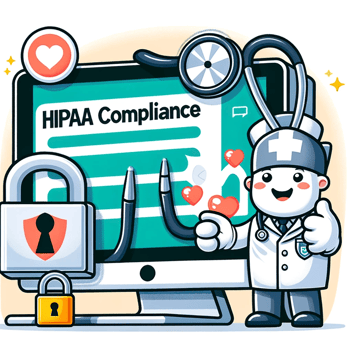
Guide to Cookie Consent: GDPR and CCPA Cookie Compliance Made Easy
This post may contain affiliate links, which means I may receive a commission if you click a link and purchase something that I have recommended. Thank you!
In an era where digital privacy is in the spotlight, cookie consent has emerged as a critical piece in the puzzle of online compliance. Navigating the intricate waters of data protection laws like the General Data Protection Regulation (GDPR) and the California Consumer Privacy Act (CCPA) can be daunting.
It's important to note that I am not a lawyer, and my insights throughout this guide are not intended as legal advice. They are shared to help demystify the process and offer practical steps towards achieving compliance.
Due to the complexity of these regulations and my non-legal background, we utilize the expertise of platforms like Termly.io for managing cookie consent effectively—a tool we will explore in more detail later in this article. This guide is designed to provide clarity, distill best practices, and present easy-to-implement solutions that enhance user trust and business growth through transparent data practices.
So, while I may not be a legal expert, this guide is the culmination of thorough research and the practical application of reliable resources to make GDPR and CCPA cookie compliance accessible for everyone.
Understanding Cookie Consent
Cookies are essential tools for modern websites, enhancing user experience by remembering login information, preferences, and various online behaviors. However, not all cookies are created equal. Some cookies, particularly those that handle personal data, require consent from the users visiting the website. Cookie consent is that explicit permission webmasters must obtain from their visitors before any data collection begins12.
In layman's terms, cookie consent is like a digital handshake between a website and its visitor, agreeing on the terms of data handling before proceeding1. This consent ensures that users are aware of and have control over their personal information being collected and processed as they browse the internet3.
The GDPR, particularly, introduced a more rigorous approach, where consent must be given before non-essential cookies can be used. This was a significant shift from the previous "opt-out" model to an "opt-in" regime, where silence or inactivity does not constitute consent4.
The Imperative of Cookie Consent for Legal Compliance
The legal landscape of digital privacy has become increasingly complex with laws like the GDPR in Europe and the CCPA in California, each with its requirements and interpretations of consent5. Compliance with these regulations is not optional; it's a mandatory part of operating a website that respects and protects user privacy.
Cookie compliance is about ensuring that the use of cookies on a website is within the boundaries set by these privacy laws67. Under GDPR, for instance, transparency is paramount—users must be fully informed about the cookies being used and their purposes. They must also have the ability to give, refuse, or withdraw consent at any time, and this choice must be respected by the website owners8.
Best practices in cookie consent not only comply with legal requirements but also foster trust with your audience. A clear and user-friendly consent mechanism is a visible sign of a company's commitment to privacy—a critical factor in customer relationship and retention in the age of data protection awareness9.
Streamlining Cookie Consent
The evolution of privacy regulations has compelled websites to adopt more transparent data practices, and streamlining the process of obtaining cookie consent is a critical step in this direction. A user-friendly cookie consent banner is more than just a legal requirement; it is an opportunity to communicate your commitment to privacy and to enhance the user experience on your website.
Implementing User-Friendly Cookie Consent Banner
A user-friendly cookie consent banner should seamlessly integrate with your website's design, providing a layout optimized for different devices and explaining cookie usage in plain, jargon-free language1. Get your user's consent. It's not just about legal adherence; it's about clarity and the ease with which users can understand what they're consenting to. The banner must identify the cookies in use, inform users about them, and obtain their consent in a clear and unambiguous manner23.
To ensure GDPR compliance, the language used in the banner must be specific, informed, and unambiguous, as defined by Article 4 of the GDPR. Moreover, the banner should be accessible at any time, allowing users to change their cookie preferences or withdraw consent as they wish45.
Leveraging Consent for Trust and Growth
Building trust through consent management is pivotal in today’s data-driven business landscape. A purpose-based consent and preference management process not only aligns with privacy compliance but also improves customer experience by respecting their data preferences. This approach has tangible benefits, such as fostering brand loyalty, personalizing customer experiences, and driving revenue growth through higher-performing campaigns.
By clearly communicating the purpose of data collection and allowing users to modify their data preferences, organizations can unlock the power of consented data. This consent empowers personalized customer experiences and fuels responsible data-driven innovation78. The return on investment for an effective consent management system is significant, as it helps businesses build trust with customers, unlock personalized experiences, and minimize the risk of non-compliance.
For more comprehensive insights into the ROI of purpose-based consent and preference management, OneTrust offers a detailed exploration of how consent management can be a pivotal factor for business growth and trust-building.
Cookie Law: Navigating the Legal Landscape
Navigating the intricate mosaic of global privacy regulations is essential for businesses with an online presence. We're diving into the cornerstone legislations that impact cookie consent and examining the must-haves for any website's cookie policy.
A Deep Dive into Cookie Consent Legislation and Data Privacy Law
The General Data Protection Regulation (GDPR) of the European Union has been a trailblazer, shaping privacy laws with its stringent consent requirements. It's become a de facto standard, influencing businesses worldwide to adopt a proactive "opt-in" model for privacy consent.
Across the pond, the United States approaches privacy with a more decentralized model. Without a federal equivalent to the GDPR, state-specific laws like the California Consumer Privacy Act (CCPA) are leading the charge. The CCPA mandates businesses to be transparent about their cookie usage and the data they collect, particularly when cookies are used for targeted advertising.
The global legal landscape is rapidly evolving, with the United Nations Conference on Trade and Development reporting that over 70% of countries now have legislation to protect data and privacy.
The Essentials of a Website's Cookie Policy
A website's cookie policy should act as a clear declaration of how and why cookies are used, detailing the types of cookies, their purpose, and guidance on user preferences. It's a transparency tool that can help foster trust with users.
Such a policy must delineate the categories of cookies utilized—be they necessary for functionality, aimed at improving performance, or used for targeting and analytics. It should also inform users how they can manage cookie settings within their browsers.
Not adhering to cookie consent laws can lead to significant fines, emphasizing the importance for businesses to remain vigilant and adaptive to comply with the diverse requirements of global jurisdictions.
Businesses with an international footprint must particularly be attentive to the regional variances in data privacy laws, tailoring cookie policies that comply and respect the varied user expectations across the globe.
For those looking to deepen their understanding of cookie consent laws, Cookie Law Info provides a guide to privacy laws in the US, and CookieYes offers insights into cookie laws in the US, both serving as valuable resources for businesses aiming to navigate this complex domain.
Crafting Your Consent Interface
Creating an interface for cookie consent is about balancing legal requirements with user experience. Let's explore how to design effective cookie consent popups and take inspiration from real-world examples.
Designing Effective Cookie Consent Popups
When crafting a cookie consent popup, consider these key elements to enhance compliance and user experience:
- Visibility: The popup should be immediately noticeable to users upon visiting the website, without obstructing content.
- Clarity: Use straightforward language to explain the use of cookies and their purpose.
- Choice: Provide users with a clear option to accept, reject, or customize their cookie preferences.
- Consistency: Ensure the design aligns with your website's branding for a cohesive look and feel.
- Accessibility: Make sure the popup is accessible to all users, including those with disabilities.
Using these principles, your cookie consent popup will not only comply with regulations but also serve as a reflection of your brand's commitment to user privacy.
Special Focus on GDPR Compliance
The GDPR sets a high bar for data privacy and cookie consent, mandating proactive engagement with users and safeguarding their personal data. A special focus on GDPR compliance is vital for businesses operating within or targeting the European market.
Ensuring GDPR Cookie Consent
To ensure GDPR cookie consent, your website must:
- Inform users clearly about the types of cookies you use and their purposes.
- Obtain explicit consent before any non-essential cookies are set.
- Record user consent in a manner that is verifiable.
- Provide an easy way for users to withdraw their consent at any time.
The GDPR emphasizes the need for consent to be a freely given, specific, informed, and unambiguous indication of the user's wishes, which translates to a robust and interactive cookie consent process on your website.
Tools for Managing Cookie Consent
Several tools can assist with managing cookie consent effectively, ensuring GDPR compliance:
- Cookie consent management platforms (CMPs): These tools help create customizable cookie consent notices that can be tailored to the specific needs of your website and its users. They often include features for tracking consent, providing reports, and ensuring that user preferences are respected across the site.
- Privacy tech vendors: Companies specializing in privacy technology offer comprehensive solutions that go beyond cookie management, providing end-to-end compliance assistance, including consent documentation and data subject rights management.
- Browser-based tools: Some web browsers offer built-in tools to help manage cookie consent and user privacy settings. These can be useful for users to control their data but require that websites recognize and respect these settings.
It is crucial to choose a tool that not only helps with compliance but also aligns with your business's specific requirements and user expectations. Selecting the right tool can streamline the consent management process, reduce the risk of non-compliance, and build trust with your audience.
Not Just EU Anymore: What's CCPA
While GDPR has been the poster child for data protection in recent years, the scope of privacy regulations has expanded with the introduction of laws like the California Consumer Privacy Act (CCPA). It's a clear sign that concerns about data privacy are becoming more widespread.
What is CCPA
The CCPA is California's answer to the growing demand for stronger data protection. It grants Californian residents new rights regarding their personal information and sets out specific obligations for businesses. Key provisions include:
- The right to know what personal data is being collected and for what purpose.
- The right to access one's personal data.
- The right to request the deletion of personal data.
- The right to opt-out of the sale of personal data.
- The right to non-discrimination for exercising privacy rights.
Do I need to honor CCPA?
Whether a business needs to honor the CCPA depends on several factors. Generally, the CCPA applies to any for-profit entity that collects consumers' personal data, does business in California, and meets any one of the following thresholds:
- Has annual gross revenues in excess of $25 million.
- Buys, receives, or sells the personal information of 50,000 or more California residents, households, or devices.
- Derives 50% or more of its annual revenues from selling California residents' personal information.
Even if your business is not based in California, if it meets any of these criteria, it is expected to comply with the CCPA. As with GDPR, the CCPA emphasizes transparency, giving consumers control over their personal information and holding businesses accountable for protecting these rights.
This marks a significant shift in the US privacy landscape, suggesting that we may see more states—or potentially federal regulations—adopt similar measures in the future.
Expanding Your Knowledge
In the fast-evolving domain of data privacy and consent, continuously expanding your knowledge is vital. Staying informed about the latest developments, best practices, and educational resources can significantly enhance your compliance strategies.
Comprehensive Resources for Privacy and Consent
A myriad of resources are available for those looking to deepen their understanding of privacy and consent:
- Official regulatory websites: For authoritative guidance, visit the European Commission’s page on data protection for GDPR, or the California Attorney General’s CCPA page for insights into CCPA.
- Privacy advocacy groups: Organizations such as the Electronic Frontier Foundation provide a wealth of information on privacy rights and digital freedoms.
- Educational platforms: Websites like FutureLearn and Coursera offer courses on data privacy and cybersecurity, often created by experts in the field.
By tapping into these resources, you can keep abreast of privacy matters, understand the implications for your business, and develop robust consent mechanisms.
Advanced Learning for Data Privacy Compliance
For those seeking a more in-depth understanding or specialization in data privacy, consider the following options:
- Professional certifications: Earning a certification from bodies like the International Association of Privacy Professionals can solidify your expertise and credibility in the field.
- Industry conferences and webinars: Engaging with thought leaders and peers through events like the Global Privacy Summit can provide valuable insights and networking opportunities.
- Academic courses: Leading universities offer advanced courses and degrees in data protection law and policy, which can be instrumental in gaining comprehensive knowledge.
Investing in advanced learning and leveraging diverse educational resources will not only enhance your compliance posture but also equip you to handle the intricacies of privacy and consent with confidence.
This is all complicated. What's the shortcut?
Navigating the multifaceted realm of cookie consent and data privacy laws can indeed be a complex task. For those looking for a streamlined approach to compliance, there are tools designed to simplify the process.
Just Use Termly.io
Termly.io is a service that offers a comprehensive solution for the often-overwhelming challenge of data privacy compliance. It provides a suite of tools that includes a cookie consent manager, privacy policy generator, and terms and conditions generator. Termly.io automates much of the consent process, offering customizable cookie consent banners that are designed to be compliant with GDPR, CCPA, and other privacy laws. The platform also manages the consent records, helping to ensure that your website remains compliant with the ever-changing landscape of data privacy regulations.
What About HubSpot
For businesses using HubSpot's CMS, there's good news. HubSpot incorporates a similar feature directly within its platform. Their cookie policy banner can be easily customized to match your company's branding while ensuring visitors are informed and can provide their consent in a way that complies with GDPR and other privacy laws. This integration can be a game-changer for HubSpot users, enabling them to address cookie consent within their existing workflow without the need for additional tools.
Both Termly.io and HubSpot offer streamlined paths to compliance, making them excellent shortcuts for businesses looking to simplify their approach to the complex requirements of data privacy.
Frequently Asked Questions
What exactly is cookie consent?
Cookie consent is the permission that a website must obtain from its visitors before tracking their behavior with cookies, especially those that collect personal data.
Why is cookie consent important for GDPR and CCPA compliance?
Under GDPR and CCPA, obtaining consent is legally required for collecting personal data through cookies. It ensures transparency and gives users control over their personal information.
How do cookies enhance user experience on a website?
Cookies remember login details, preferences, and other behaviors, making navigation smoother and more personalized for users.
What happens if a website doesn’t comply with GDPR or CCPA?
Websites may face hefty fines, legal action, and damage to their reputation for non-compliance with GDPR or CCPA regulations.
Can a user change their mind after giving cookie consent?
Yes, GDPR and CCPA both require that users be able to withdraw their consent as easily as they gave it.
What are the best practices for displaying a cookie consent banner?
Best practices include making the banner visible and clear, offering choices for consent, and ensuring it is accessible and consistent with the website’s design.
Are there tools available to help manage cookie consent?
Yes, tools like Termly.io and HubSpot’s CMS feature help businesses create compliant cookie consent banners and manage consent records.
Does CCPA only apply to businesses in California?
No, CCPA applies to any for-profit business that handles the personal data of California residents and meets certain criteria, regardless of where the business is located.
What is the significance of the 'right to know' under CCPA?
The 'right to know' allows consumers to be informed about what personal data is being collected about them and why, enhancing transparency.
How can businesses keep up with the evolving landscape of data privacy laws?
Businesses can stay informed by consulting official regulatory websites, joining privacy advocacy groups, attending industry conferences, and pursuing further education in data privacy compliance.
Embracing Transparency: The Path to Trust and Compliance
In conclusion, the journey to cookie consent compliance is an ongoing process of education, adaptation, and implementation. By understanding the essentials of cookie laws, creating user-friendly consent banners, and utilizing tools like Termly.io and HubSpot, businesses can navigate the complexities of GDPR, CCPA, and other privacy regulations.
It's not just about avoiding fines; it's about building a foundation of trust with your users by respecting their privacy and securing their data. As we embrace transparency and prioritize consent, we pave the way for a more privacy-conscious online environment where businesses and consumers can thrive in harmony.
With the right knowledge and tools, the path to compliance can become a strategic advantage, enhancing customer loyalty and driving growth in the digital age.


